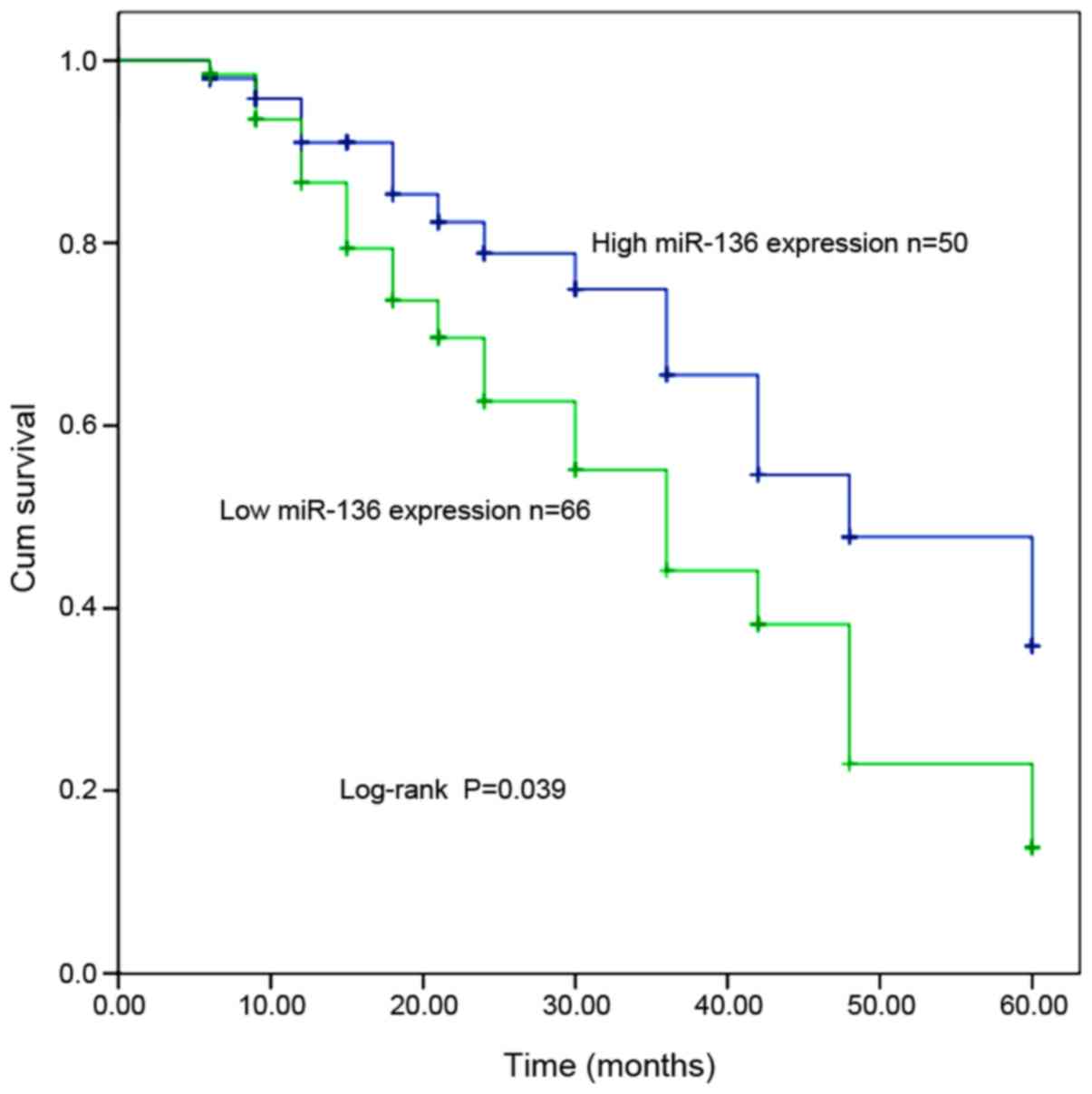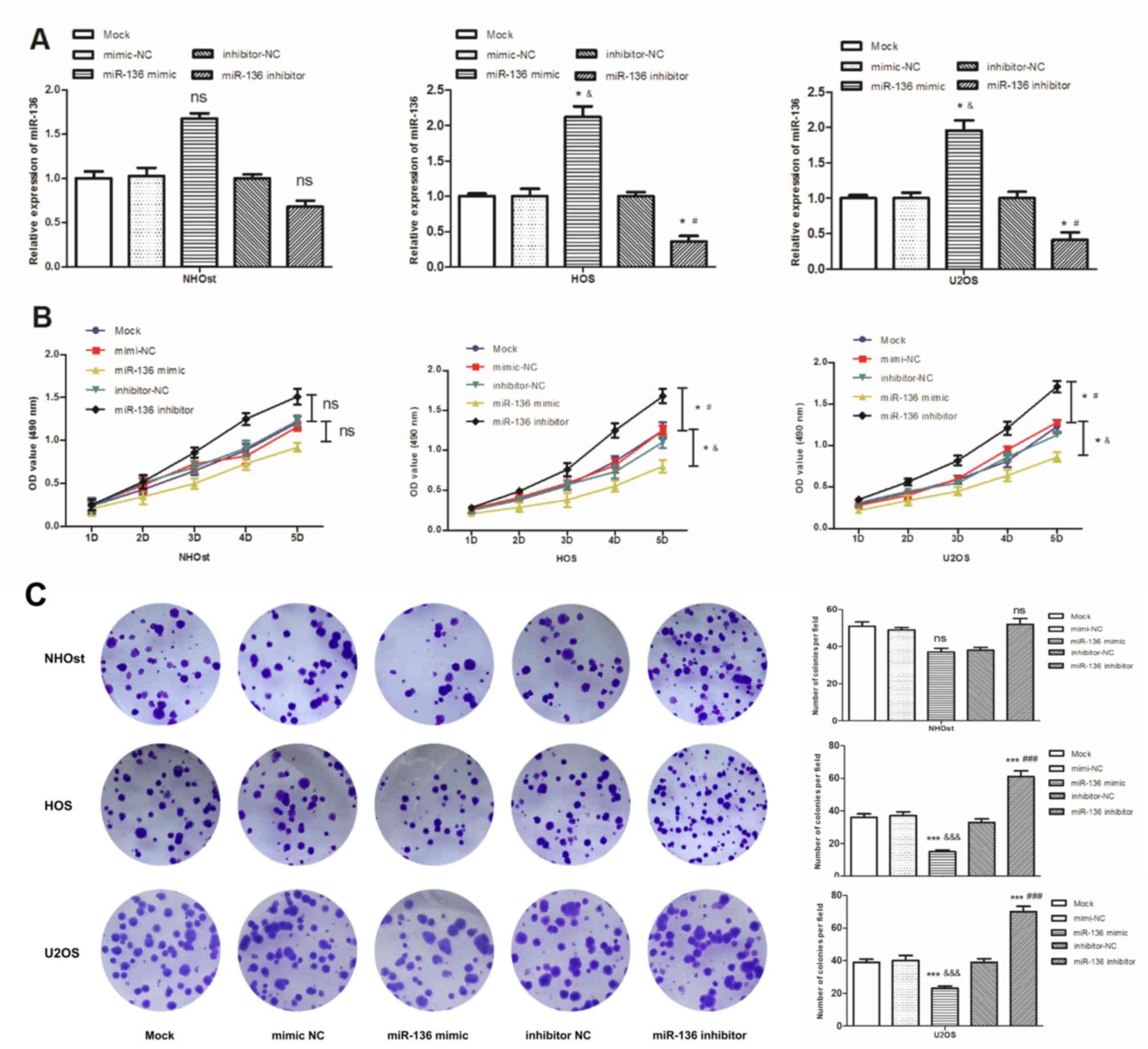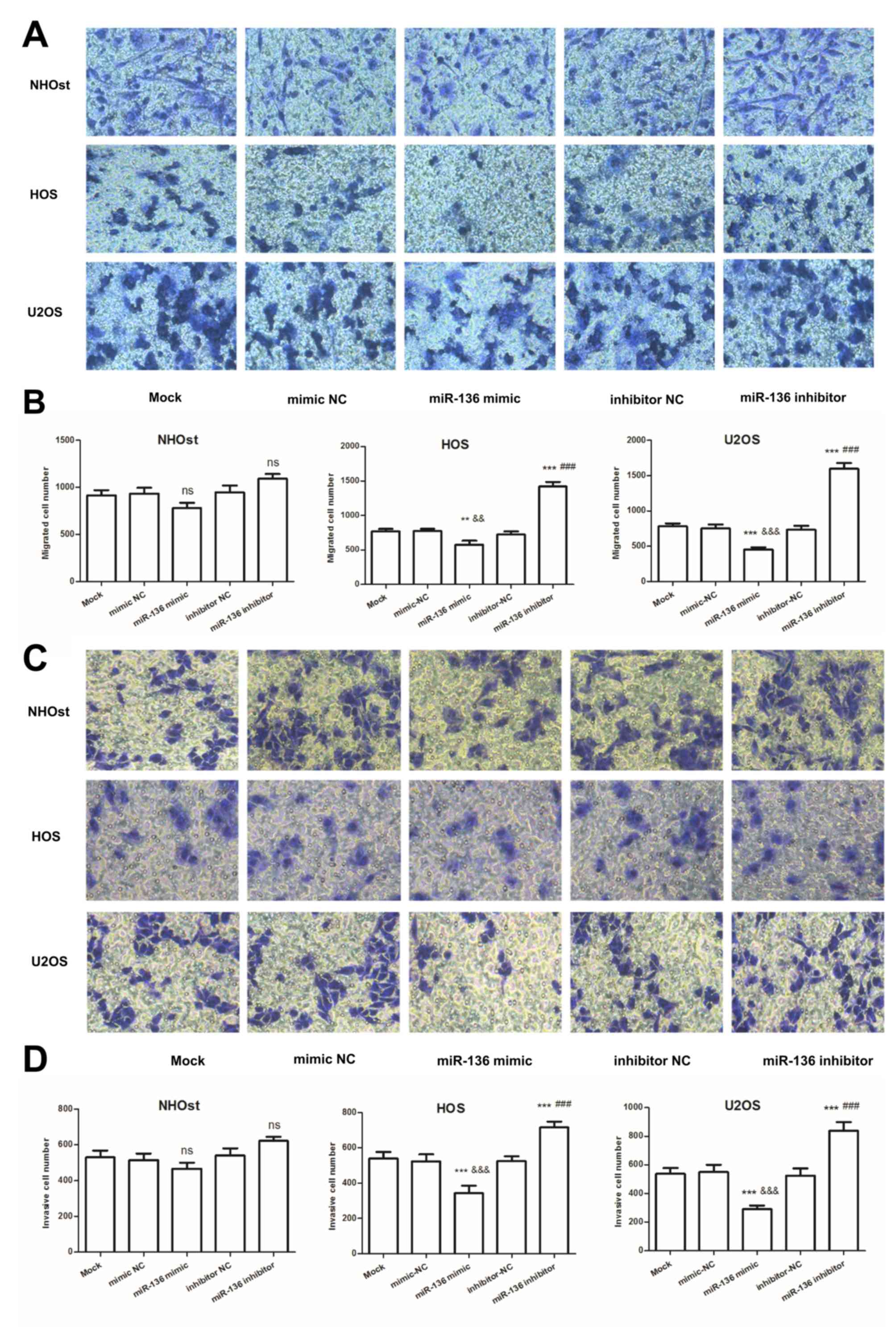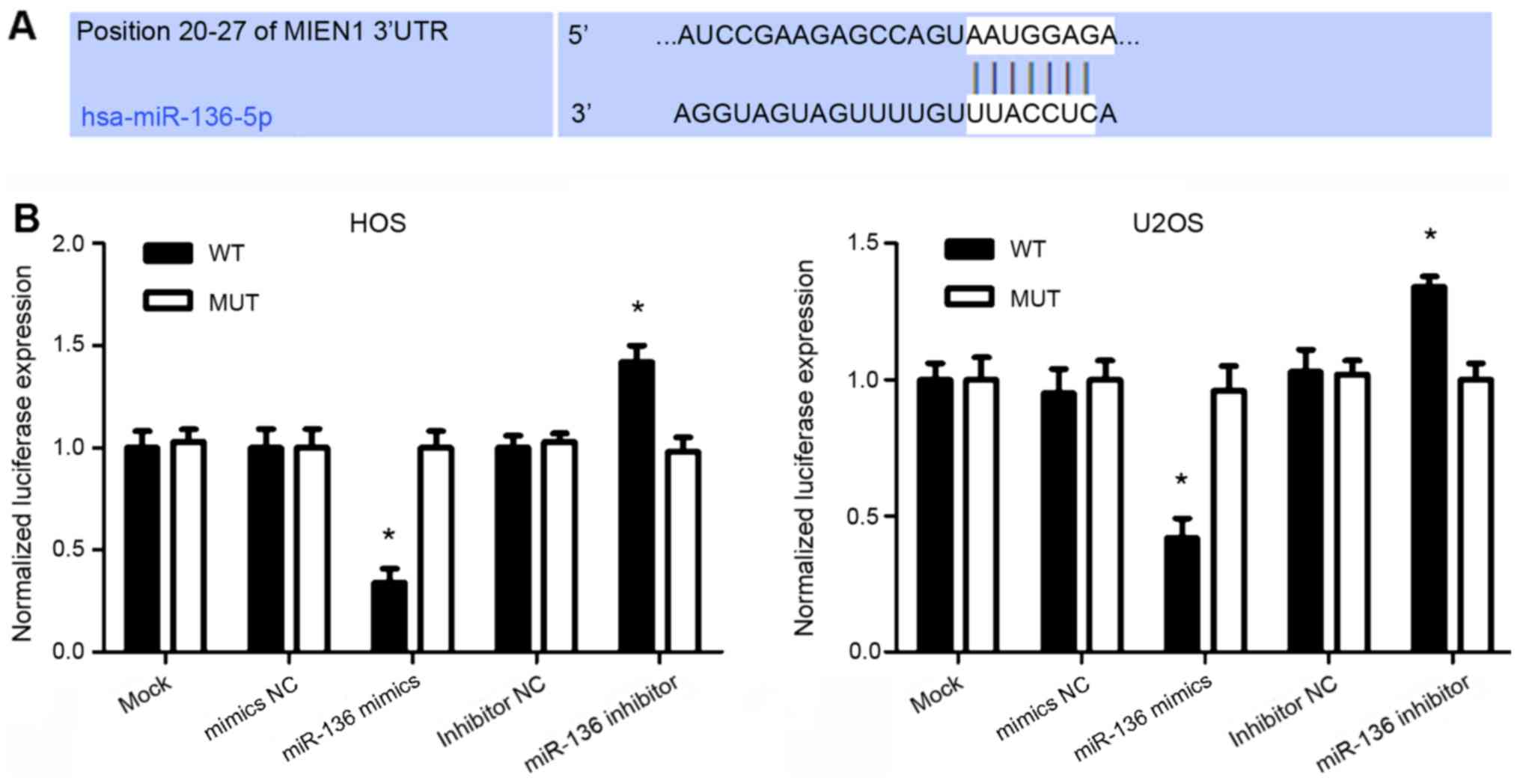|
1
|
Ottaviani G and Jaffe N: The epidemiology
of osteosarcoma. Cancer Treat Res. 152:3–13. 2009. View Article : Google Scholar : PubMed/NCBI
|
|
2
|
Ritter J and Bielack SS: Osteosarcoma. Ann
Oncol. 21 (Suppl):vii320–325. 2010. View Article : Google Scholar : PubMed/NCBI
|
|
3
|
Jones KB, Ferguson PC, Lam B, Biau DJ,
Hopyan S, Deheshi B, Griffin AM, White LM and Wunder JS: Effects of
neoadjuvant chemotherapy on image-directed planning of surgical
resection for distal femoral osteosarcoma. J Bone Joint Surg Am.
94:1399–1405. 2012. View Article : Google Scholar : PubMed/NCBI
|
|
4
|
Wong KC, Lee V, Shing MM and Kumta S:
Surgical resection of relapse may improve postrelapse survival of
patients with localized osteosarcoma. Clin Orthop Relat Res.
471:814–819. 2013. View Article : Google Scholar : PubMed/NCBI
|
|
5
|
Gill J, Ahluwalia MK, Geller D and Gorlick
R: New targets and approaches in osteosarcoma. Pharmacol Ther.
137:89–99. 2013. View Article : Google Scholar : PubMed/NCBI
|
|
6
|
Meazza C and Scanagatta P: Metastatic
osteosarcoma: A challenging multidisciplinary treatment. Exp Rev
Anticancer Ther. 16:543–556. 2016. View Article : Google Scholar
|
|
7
|
Farazi TA, Hoell JI, Morozov P and Tuschl
T: MicroRNAs in human cancer. Adv Exp Med Biol. 774:1–20. 2013.
View Article : Google Scholar : PubMed/NCBI
|
|
8
|
Wang G, Zhu S, Gu Y, Chen Q, Liu X and Fu
H: MicroRNA-145 and microRNA-133a inhibited proliferation,
migration, and invasion, while promoted apoptosis in hepatocellular
carcinoma cells via targeting FSCN1. Dig Dis Sci. 60:3044–3052.
2015. View Article : Google Scholar : PubMed/NCBI
|
|
9
|
Li C, Zhao L, Chen Y, He T, Chen X, Mao J,
Li C, Lyu J and Meng QH: MicroRNA-21 promotes proliferation,
migration, and invasion of colorectal cancer, and tumor growth
associated with down-regulation of sec23a expression. BMC Cancer.
16:6052016. View Article : Google Scholar : PubMed/NCBI
|
|
10
|
Nishikawa R, Goto Y, Kurozumi A,
Matsushita R, Enokida H, Kojima S, Naya Y, Nakagawa M, Ichikawa T
and Seki N: MicroRNA-205 inhibits cancer cell migration and
invasion via modulation of centromere protein F regulating pathways
in prostate cancer. Int J Urol. 22:867–877. 2015. View Article : Google Scholar : PubMed/NCBI
|
|
11
|
Zhu J, Liu F, Wu Q and Liu X: MiR-221
increases osteosarcoma cell proliferation, invasion and migration
partly through the downregulation of PTEN. Int J Mol Med.
36:1377–1383. 2015. View Article : Google Scholar : PubMed/NCBI
|
|
12
|
Xu M, Jin H, Xu CX, Bi WZ and Wang Y:
MiR-34c inhibits osteosarcoma metastasis and chemoresistance. Med
Oncol. 31:9722014. View Article : Google Scholar : PubMed/NCBI
|
|
13
|
Zhao H, Ma B, Wang Y, Han T, Zheng L, Sun
C, Liu T, Zhang Y, Qiu X and Fan Q: miR-34a inhibits the metastasis
of osteosarcoma cells by repressing the expression of CD44. Oncol
Rep. 29:1027–1036. 2013. View Article : Google Scholar : PubMed/NCBI
|
|
14
|
Mosakhani N, Pazzaglia L, Benassi MS,
Borze I, Quattrini I, Picci P and Knuutila S: MicroRNA expression
profiles in metastatic and non-metastatic giant cell tumor of bone.
Histol Histopathol. 28:671–678. 2013.PubMed/NCBI
|
|
15
|
Yuan Q, Cao G, Li J, Zhang Y and Yang W:
MicroRNA-136 inhibits colon cancer cell proliferation and invasion
through targeting liver receptor homolog-1/Wnt signaling. Gene.
628:48–55. 2017. View Article : Google Scholar : PubMed/NCBI
|
|
16
|
Lu HJ, Jin PY, Tang Y, Fan SH, Zhang ZF,
Wang F, Wu DM, Lu J and Zheng YL: microRNA-136 inhibits
proliferation and promotes apoptosis and radiosensitivity of
cervical carcinoma through the NF-kappaB pathway by targeting E2F1.
Life Sci. 199:167–178. 2018. View Article : Google Scholar : PubMed/NCBI
|
|
17
|
Jia H, Wang H, Yao Y, Wang C and Li P:
miR-136 inhibits malignant progression of hepatocellular carcinoma
cells by targeting cyclooxygenase 2. Oncol Res. 26:967–976. 2018.
View Article : Google Scholar : PubMed/NCBI
|
|
18
|
Biermann JS, Chow W, Reed DR, Lucas D,
Adkins DR, Agulnik M, Benjamin RS, Brigman B, Budd GT, Curry WT, et
al: NCCN guidelines insights: Bone cancer, version 2.2017. J Natl
Compr Canc Netw. 15:155–167. 2017. View Article : Google Scholar : PubMed/NCBI
|
|
19
|
Cates JM: Comparison of the AJCC, MSTS,
and modified spanier systems for clinical and pathologic staging of
osteosarcoma. Am J Surg Pathol. 41:405–413. 2017. View Article : Google Scholar : PubMed/NCBI
|
|
20
|
Livak KJ and Schmittgen TD: Analysis of
relative gene expression data using real-time quantitative PCR and
the 2(-Delta Delta C(T)) method. Methods. 25:402–408. 2001.
View Article : Google Scholar : PubMed/NCBI
|
|
21
|
Shen S, Yue H, Li Y, Qin J, Li K, Liu Y
and Wang J: Upregulation of miR-136 in human non-small cell lung
cancer cells promotes Erk1/2 activation by targeting PPP2R2A.
Tumour Biol. 35:631–640. 2014. View Article : Google Scholar : PubMed/NCBI
|
|
22
|
Zhang H, Cai X, Wang Y, Tang H, Tong D and
Ji F: microRNA-143, down-regulated in osteosarcoma, promotes
apoptosis and suppresses tumorigenicity by targeting Bcl-2. Oncol
Rep. 24:1363–1369. 2010.PubMed/NCBI
|
|
23
|
Poos K, Smida J, Maugg D, Eckstein G,
Baumhoer D, Nathrath M and Korsching E: Genomic heterogeneity of
osteosarcoma-shift from single candidates to functional modules.
PLoS One. 10:e01230822015. View Article : Google Scholar : PubMed/NCBI
|
|
24
|
Hass HG, Jobst J, Vogel U, Scheurlen M and
Nehls O: Overexpression of tumor-associated trypsin inhibitor
(SPINK1/TATI) in hepatitis C-associated hepatocellular carcinoma:
Potential implications for viral hepatocarcinogenesis. Oncol Res
Treat. 37:732–738. 2014. View Article : Google Scholar : PubMed/NCBI
|
|
25
|
Karakus N, Kara N, Ulusoy AN, Ozaslan C,
Tural S and Okan I: Evaluation of CYP17A1 and LEP gene
polymorphisms in breast cancer. Oncol Res Treat. 38:418–422. 2015.
View Article : Google Scholar : PubMed/NCBI
|
|
26
|
Dimberg J, Olsen RS, Skarstedt M, Lofgren
S, Zar N and Matussek A: Polymorphism of the p38β gene in patients
with colorectal cancer. Oncol Lett. 8:1093–1095. 2014. View Article : Google Scholar : PubMed/NCBI
|
|
27
|
Hou G, Chen B, Xu W, Zhao H, Liu K and Yao
H: Expression level of CDC2 gene in osteosarcoma and its clinical
significance. Oncol Lett. 15:7884–7888. 2018.PubMed/NCBI
|
|
28
|
Fernanda Amary M, Ye H, Berisha F, Khatri
B, Forbes G, Lehovsky K, Frezza AM, Behjati S, Tarpey P, Pillay N,
et al: Fibroblastic growth factor receptor 1 amplification in
osteosarcoma is associated with poor response to neo-adjuvant
chemotherapy. Cancer Med. 3:980–987. 2014. View Article : Google Scholar : PubMed/NCBI
|
|
29
|
Liang S, Ren Z, Han X, Yang J, Shan L, Li
L, Wang B, Zhang Q, Mu T, Chen K, et al: PLA2G16 expression in
human osteosarcoma is associated with pulmonary metastasis and poor
prognosis. PLoS One. 10:e01272362015. View Article : Google Scholar : PubMed/NCBI
|
|
30
|
Fesler A, Zhai H and Ju J: miR-129 as a
novel therapeutic target and biomarker in gastrointestinal cancer.
Onco Targets Ther. 7:1481–1485. 2014.PubMed/NCBI
|
|
31
|
Zavala V, Perez-Moreno E, Tapia T, Camus M
and Carvallo P: miR-146a and miR-638 in BRCA1-deficient triple
negative breast cancer tumors, as potential biomarkers for improved
overall survival. Cancer Biomark. 16:99–107. 2016. View Article : Google Scholar : PubMed/NCBI
|
|
32
|
Jiang Y, Luan Y, Chang H and Chen G: The
diagnostic and prognostic value of plasma microRNA-125b-5p in
patients with multiple myeloma. Oncol Lett. 16:4001–4007.
2018.PubMed/NCBI
|
|
33
|
Taheriazam A, Talaei AJ, Jamshidi M,
Shakeri M, Khoshbakht S, Yahaghi E and Shokrani M: Up-regulation of
miR-130b expression level and down-regulation of miR-218 serve as
potential biomarker in the early detection of human osteosarcoma.
Diagn Pathol. 10:1842015. View Article : Google Scholar : PubMed/NCBI
|
|
34
|
Ren H, Qi Y, Yin X and Gao J: miR-136
targets MIEN1 and involves the metastasis of colon cancer by
suppressing epithelial-to-mesenchymal transition. Onco Targets
Ther. 11:67–74. 2018. View Article : Google Scholar : PubMed/NCBI
|
|
35
|
Chen P, Zhao L, Pan X, Jin L, Lin C, Xu W,
Xu J, Guan X, Wu X, Wang Y, et al: Tumor suppressor microRNA-136-5p
regulates the cellular function of renal cell carcinoma. Oncol
Lett. 15:5995–6002. 2018.PubMed/NCBI
|
|
36
|
Rajendiran S, Kpetemey M, Maji S, Gibbs
LD, Dasgupta S, Mantsch R, Hare RJ and Vishwanatha JK: MIEN1
promotes oral cancer progression and implicates poor overall
survival. Cancer Biol Ther. 16:876–885. 2015. View Article : Google Scholar : PubMed/NCBI
|
|
37
|
Kpetemey M, Dasgupta S, Rajendiran S, Das
S, Gibbs LD, Shetty P, Gryczynski Z and Vishwanatha JK: MIEN1, a
novel interactor of Annexin A2, promotes tumor cell migration by
enhancing AnxA2 cell surface expression. Mol Cancer. 14:1562015.
View Article : Google Scholar : PubMed/NCBI
|
|
38
|
Li D, Wei Y, Wang D, Gao H and Liu K:
MicroRNA-26b suppresses the metastasis of non-small cell lung
cancer by targeting MIEN1 via NF-kappaB/MMP-9/VEGF pathways.
Biochem Biophys Res Commun. 472:465–470. 2016. View Article : Google Scholar : PubMed/NCBI
|
|
39
|
Rajendiran S, Parwani AV, Hare RJ,
Dasgupta S, Roby RK and Vishwanatha JK: MicroRNA-940 suppresses
prostate cancer migration and invasion by regulating MIEN1. Mol
Cancer. 13:2502014. View Article : Google Scholar : PubMed/NCBI
|
|
40
|
Yan M, Li X, Tong D, Han C, Zhao R, He Y
and Jin X: miR-136 suppresses tumor invasion and metastasis by
targeting RASAL2 in triple-negative breast cancer. Oncol Rep.
36:65–71. 2016. View Article : Google Scholar : PubMed/NCBI
|
|
41
|
Yang Y, Liu L, Cai J, Wu J, Guan H, Zhu X,
Yuan J, Chen S and Li M: Targeting Smad2 and Smad3 by miR-136
suppresses metastasis-associated traits of lung adenocarcinoma
cells. Oncol Res. 21:345–352. 2013. View Article : Google Scholar : PubMed/NCBI
|














